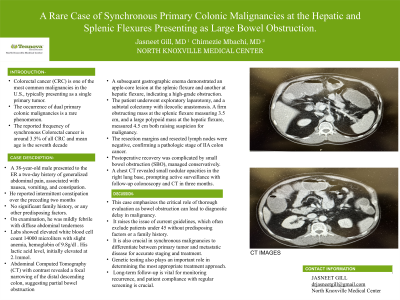Tuesday Poster Session
Category: Colon
P4665 - A Rare Case of Synchronous Primary Colonic Malignancies at the Hepatic and Splenic Flexures Presenting as Large Bowel Obstruction

- JG
Jasneet Gill, MBBS, MD
North Knoxville Medical Center
Knoxville, TN
Presenting Author(s)
1North Knoxville Medical Center, Knoxville, TN; 2NORTH KNOXVILLE MEDICAL CENTER, Knoxville, TN
Introduction:
Colorectal cancer (CRC) is one of the most common malignancies in the U.S., typically presenting as a single primary tumor. However, the occurrence of dual primary colonic malignancies is a rare phenomenon. The reported frequency of synchronous Colorectal cancer is around 3.5% of all CRC and mean age is the seventh decade.
Case Description/Methods:
A 38-year-old male presented to the ER with a two-day history of generalized abdominal pain, associated with nausea, vomiting, and constipation. He reported intermittent constipation over the preceding two months. No significant family history, or any other predisposing factors. On examination, he was was mildly febrile with diffuse abdominal tenderness. Labs showed elevated white blood cell count of 14000 microliters with slight anemia, hemoglobin of 9.8g/dl . His lactic acid level, initially elevated at 2.1mmol. Abdominal Computed Tomography (CT) with contrast revealed a focal narrowing of the distal descending colon, suggesting partial bowel obstruction. A subsequent gastrographic enema demonstrated an apple-core lesion at the splenic flexure and another at hepatic flexure, indicating a high-grade obstruction. The patient underwent exploratory laparotomy, and a subtotal colectomy with ileocolic anastomosis. A firm obstructing mass at the splenic flexure measuring 3.5 cm, and a large polypoid mass at the hepatic flexure, measured 4.5 cm both raising suspicion for malignancy. The resection margins and resected lymph nodes were negative, confirming a pathologic stage of IIA colon cancer. Postoperative recovery was complicated by small bowel obstruction (SBO), managed conservatively. A chest CT revealed small nodular opacities in the right lung base, prompting active surveillance with follow-up colonoscopy and CT in three months.
Discussion: This case emphasizes the critical role of thorough evaluation as bowel obstruction can lead to diagnostic delay in malignancy. It raises the issue of current guidelines, which often exclude patients under 45 without predisposing factors or a family history. It is also crucial in synchronous malignancies to differentiate between primary tumor and metastatic disease for accurate staging and treatment. Genetic testing also plays an important role in determining the most appropriate treatment approach. Additionally, long-term follow-up is vital for monitoring recurrence, and patient compliance with regular screening is crucial.
Disclosures:
Jasneet Gill, MBBS, MD1, Chimezie Mbachi, MD2. P4665 - A Rare Case of Synchronous Primary Colonic Malignancies at the Hepatic and Splenic Flexures Presenting as Large Bowel Obstruction, ACG 2025 Annual Scientific Meeting Abstracts. Phoenix, AZ: American College of Gastroenterology.
